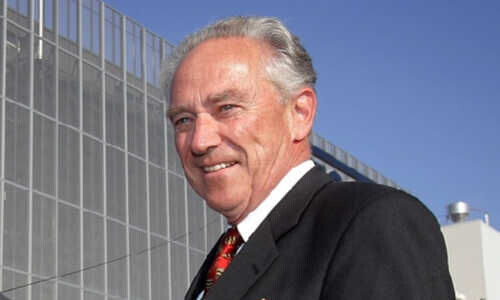Legendary Swiss banker Rainer E. Gut passed away Wednesday at 91. Few other personalities from the local financial scene played such a decisive role in shaping events over several decades. Much has been written about him, but some less well-known facts exist.
1. Career First at UBS
It goes unmentioned on Wikipedia that Rainer Gut worked for UBS, née Swiss Bank Corporation (SBC), in the 1960s and was responsible for its headquarters in New York. At that time, UBS sought a resolution for its problematic participation in IG Farben.
Two leading SBG bankers at the time, Alfred Schaefer and Robert Holzach, were busy shuttling back and forth to New York with Gut, about 30 years old, acting as liaison. SBG eventually concluded the matter, but Gut left empty-handed in the promotion race. Holzach eventually offered him a consolation prize of sorts with the position of director of the commercial department in Zurich responsible for major international customers. The self-confident and well-connected Gut respectfully declined.
He had greater ambitions and wanted to stay in traditional finance. In 1968, he left and joined the investment bank Lazard Frères, acquiring the foundational knowledge for later initiatives at Credit Suisse First Boston (CSFB). However, he always remained connected to UBS at heart, which became apparent in 1996 (see point 8).
In 1971, Gut moved from Lazard Frères to Swiss American Corporation in New York, a U.S. investment banking affiliate of what was then Schweizerische Kreditanstalt (SKA, later Credit Suisse, CS).
2. A Phoenix Following the Chiasso Scandal
In the spring of 1977, the Swiss banking industry experienced its biggest scandal. For years, the then-head of the SKA (later Credit Suisse) branch in the Ticino border town of Chiasso placed billions in client funds with the holding company of a Liechtenstein institution. He then granted guarantees to his clients, which were booked off the bank's balance sheet.
This criminal activity led to a huge debacle, the Chiasso scandal. Various SKA executives had to go, notably Heinz R. Wuffli, father of future UBS Group CEO Peter Wuffli, and the then chairman of the General Management. However, it turned out he was only the biggest pawn.
With the scandal, Gut's hour had arrived. He was one of the few young executives not been involved in the debacle. He succeeded Wuffli and was promoted to spokesman of the General Management in May 1977 before being appointed its chairman in 1982.
3. Establishment Antithesis
With Gut's rise to the top of the SKA power structure, something astonishing happened. The man from central Switzerland didn't tick the boxes of the traditional requirements of the Zurich bank. Gut wasn't a Zurich native, non-academic, and Catholic. As neither a guild member nor a Rotarian, he was often overlooked for a suite on the executive floor.
But times were changing within the SKA. Gut ushered in a more international and unabashedly American era, and the SKA set out for new shores. Several decades followed under the aegis of Gut, who became the uncontested ruler of Zurich's Paradeplatz and one of the most influential string pullers in the Swiss economy through a series of board of directorships.
4. From a Noble Bank to one for the Masses
Under Gut's leadership, not only did SKA go on a PR offensive by sponsoring the «Tour de Suisse» cycling race in 1978, but it also transformed itself from a bank for Zurich's elite into a financial institution that addressed the middle classes. With that, it morphed into a retail bank, an important decision in order to stand up to other major Swiss banks.
At the same time, it became increasingly involved in US investment banking, a domain with which Gut had always been associated since his Lazard Frères days. The result was CSFB, an investment bank that, after numerous transactions and reorganizations, should've helped Credit Suisse achieve global stature.
Although Gut managed to gather some of the best investment bankers around him, such as Robert Genillard, Hans-Joerg Rudloff, and, last but not least, Oswald Gruebel, Credit Suisse investment banking was a ruinous enterprise that ultimately contributed to the downfall of the entire bank.
5. Critical Mass
For the most part, Gut avoided media publicity, and there are only a few interviews of him, considering his importance and long tenure, speaking only when he had an important message to convey. It was all the more surprising when his biography «Die kritische Groesse» appeared in 2007.
The book was written with help from Credit Suisse's chief historian at the time, Joseph Jung. At times, it lacks the necessary distance from Gut in terms of content, but it nonetheless contains a wealth of data and information of great value to appraise Swiss banking history.
Gut comes across credibly as a reformed, well-considered, and already contemplative man but also notes he kept his ambitions in mind as he strove for power.
6. Credit Suisse First Boston «Culture Clash»
Credit Suisse undoubtedly made the most progress in US investment banking compared to all other major Swiss banks, but that was never sustainable. Those under Gut's leadership always faced accusations they were using the stable earnings from private banking to subsidize the volatile and short-term business of Credit Suisse's Wall Street bankers.
This resulted in a transatlantic culture war that Credit Suisse could never bring under control. Precisely because investment banking, by its very nature, devours a great deal of resources, Credit Suisse's management's misjudgments proved fatal.
This was the case with the oversized billion-dollar takeover of US investment bank Donaldson Lufkin & Jenrette (DLJ) in 2000, which never paid off. The excesses surrounding Greensill and Archegos in the last few years also weighed down Credit Suisse before it finally disappeared.
7. On Par with the Americans
Nevertheless, there have also been times when Credit Suisse and the Swiss financial industry benefited from Gut's American flair. This was the case in the late 1990s when Switzerland was embroiled in the dormant assets of Jewish bank clients and their heirs.
The hard-fought disputes with the US judiciary, which lasted several years, finally ended in a settlement on August 12, 1998, when Swiss banks agreed to pay Holocaust victims 1.25 billion Swiss francs. In addition to Hans J. Baer and diplomat Thomas Borer, it was, above all, Gut who brought about this important resolution for the Swiss banks and the reputation of the Swiss financial industry.
8. Unsuccessful Merger Attempt
On April 1, 1996, Gut submitted a merger proposal to his counterpart at SBG, Nikolaus Senn, who was caught off guard while on a Florida golf vacation. Before Gut could confirm his exploratory talk with a letter to the SBG Board of Directors, SBG had brought the case to the public via the «Tages-Anzeiger.» On April 9, the newspaper ran the headline: «Credit Suisse wants power over SBG.»
While Gut was exposed, his proposal wasn't entirely pulled out of thin air. In the summer of 1996, Gut announced the restructuring of Credit Suisse Holding. For the first time, an international financial group worthy of the name was created in Switzerland. Credit Suisse Group comprised four largely independent divisions: Private Banking, Asset Management, Retail Banking, and Investment Banking (CSFB).
The real novelty was those in charge now had targets for return on equity in each business unit. Credit Suisse was responding to an increasingly influential group in the financial world: shareholders and financier Martin Ebner, who helped the concept of shareholder value make a breakthrough and take off in Switzerland.
9. Insurance Misjudgement
Against radical changes in the banking industry in general, Gut, in the second half of the 1990s, pursued a merger with the Winterthur insurance group. This vision of bancassurance emerged based on the idea for banks to offer insurance products and vice versa.
In August 1997, Credit Suisse and Winterthur joined forces. Still, the bancassurance dream proved unsustainable in practice in Switzerland, where two entirely different corporate cultures clashed and failed to deliver added value.
It was up to Gruebel, who later became head of Credit Suisse, to sell Winterthur during a difficult time for the ailing bank. It was eventually sold to France's Axa Group in 2006.
10. Hope and Horror Over Credit Suisse

Rainer E. Gut and Tidjane Thiam in Spring 2015 in Zurich (Image: finews.com)
Until this spring, Gut remained closely associated with Credit Suisse as an honorary chairman. For many years, he maintained an office at the bank's headquarters on Zurich's Paradeplatz, where he would sometimes walk to the nearby bank-owned Savoy Baur en Ville hotel. As late as 2019, he was still very concerned about the bank's dramatic development.
Gut was working towards (then chairman) Urs Rohner stepping down as chairman before 2021, which was the discussion in Zurich banking circles at the time. Gut accused Rohner of passively watching the conflict between Group CEO Tidjane Thiam and asset management chief Iqbal Khan for too long. Subsequently, he said, Rohner had not mediated but facilitated Khan's move to UBS, bypassing the CEO.
His level of concern is remarkable in that Gut had surprisingly paid his respects at the media conference in Zurich when Thiam was appointed in the spring of 2015 (picture above). Very few people had expected this. A mutual admiration was palpable between the two, and Gut expressed much hope that went unfulfilled. The rest is history.



































